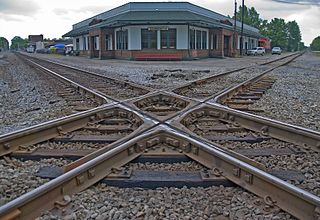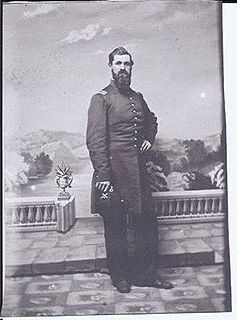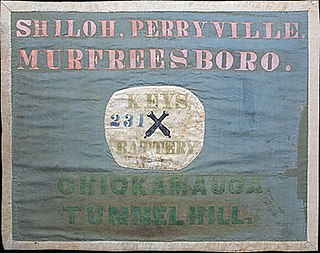Service
Byrne first offered his services to P.G.T. Beauregard in South Carolina, but upon learning that Fort Sumter had already fallen, he decided to attach his battery to the organization now forming at Camp Boone that would later become famous as the Orphan Brigade. The battery saw its first minor action on the advance into Kentucky led by General Simon B. Buckner. Byrne's Battery, along with the 2nd Kentucky Infantry, led the advance into Kentucky late in 1861 and captured guns and men along the way, along with many of the pro-Union Homeguard of Kentucky and some of regular and volunteer troops. This advance led to the capture of Bowling Green and the subsequent set-up of the later exiled Confederate Government of Kentucky.
After the withdrawal from Kentucky, they saw heavy action at the Battle of Shiloh, where the battery was completely overrun despite the men's best efforts to save the guns. Confederate infantry soon recovered the guns and the battery later supported Daniel Ruggles' assault on the "Hornet's Nest" as part of Ruggles' Grand Battery. Even after the bloody fight at Shiloh and the loss of many men, Byrne's Battery continued to serve heroically and effectively in the Orphan Brigade. They participated in every battle of the Orphan Brigade up to Stones River, where they gallantly and defiantly stood to their guns despite overwhelming enemy fire. One gunner lost his hand to an enemy round, but still stayed at his post. Because of its tremendous losses at Stones River, Byrne's Battery was forced to disband and disperse itself amongst the other Kentucky units and even units outside the Orhan Brigade, although though most were simply directly transferred to Lyon's (Cobb's) Battery.
After their disbandment, Edward Byrne was commissioned a colonel and placed in command of all Kentucky cavalry companies not already organized into regiments. Byrne was ordered to report to General Morgan after the organization of these companies. But this did not satisfy Byrne and he requested permission to form another battery and be made Chief of Artillery of Morgan's cavalry. His request was granted, but his commission was amended by Confederate Congress to that of a Major. He began forming this new battery from elements of his old battery and from new recruits from Kentucky.
Byrne went on to serve with distinction under Morgan and commanded the artillery on several of his raids until he was court-martialed for his involvement in a bank robbery on one of those raids. The men not transferred back to his new unit continued to serve in various units, especially Cobb's Battery of the Orphan Brigade, until they were surrendered by Joseph E. Johnston on April 26, 1865, at Bennett Place. The remnants of Byrne's Battery were paroled on May 10.

The Battle of Shiloh was a battle in the Western Theater of the American Civil War, fought April 6–7, 1862, in southwestern Tennessee. A Union force known as the Army of the Tennessee had moved via the Tennessee River deep into Tennessee and was encamped principally at Pittsburg Landing on the west bank of the Tennessee River, where the Confederate Army of Mississippi launched a surprise attack on Grant's army from its base in Corinth, Mississippi. Johnston was mortally wounded during the fighting; Beauregard took command of the army and decided against pressing the attack late in the evening. Overnight, Grant was reinforced by one of his divisions stationed farther north and was joined by three divisions from the Army of the Ohio. The Union forces began an unexpected counterattack the next morning which reversed the Confederate gains of the previous day.

The Battle of Perryville was fought on October 8, 1862, in the Chaplin Hills west of Perryville, Kentucky, as the culmination of the Confederate Heartland Offensive during the American Civil War. Confederate Gen. Braxton Bragg's Army of Mississippi initially won a tactical victory against primarily a single corps of Maj. Gen. Don Carlos Buell's Union Army of the Ohio. The battle is considered a strategic Union victory, sometimes called the Battle for Kentucky, since Bragg withdrew to Tennessee soon thereafter. The Union retained control of the critical border state of Kentucky for the remainder of the war.

The Battle of Belmont was fought on November 7, 1861 in Mississippi County, Missouri. It was the first combat test in the American Civil War for Brig. Gen. Ulysses S. Grant, the future Union Army general in chief and eventual U.S. president, who was fighting Major General Leonidas Polk. Grant's troops in this battle were the "nucleus" of the Union Army of the Tennessee.

The siege of Corinth was an American Civil War engagement lasting from April 29 to May 30, 1862, in Corinth, Mississippi. A collection of Union forces under the overall command of Major General Henry Halleck engaged in a month-long siege of the city, whose Confederate occupants were commanded by General P.G.T. Beauregard. The siege resulted in the capture of the town by Federal forces.

The Orphan Brigade was the nickname of the First Kentucky Brigade, a group of military units recruited from Kentucky to fight for the Confederate States of America during the American Civil War. The brigade was the largest Confederate unit to be recruited from Kentucky during the war. Its original commander was John C. Breckinridge, former United States Vice President and candidate for president, who was enormously popular with Kentuckians.

Daniel Ruggles was a Brigadier General in the Confederate States Army during the American Civil War. He is best remembered as a division commander at the Battle of Shiloh.

The 1st Kentucky Artillery was an artillery battery that was a member of the Orphan Brigade in the Confederate States Army during the American Civil War. It fought in several engagements throughout the Western Theater, including the battles of Shiloh, Baton Rouge, Siege of Jackson, Sulphur Trestle, Resaca, Murfreesboro, Jonesborough, Chickamauga, Missionary Ridge, and Johnsonville. Following the end of the Atlanta Campaign, Cobb's Battery was detached from the Orphan Brigade and reassigned to defend Mobile, Alabama.

Battery "E", 1st Regiment Illinois Volunteer Light Artillery was an artillery battery that served in the Union Army during the American Civil War. It played a minor but noteworthy role in the Battle of Shiloh, and was mentioned in General William T. Sherman's after-action report on the battle. It also served at Vicksburg, Brice's Crossroads, Nashville and in several other engagements in the Western Theater of the war.
2nd Arkansas Light Artillery, (1860–1865) was a Confederate Army artillery battery which served during the American Civil War. The battery spent the majority of the war serving in Confederate forces east of the Mississippi River. The battery is also referred to as the Clark County Artillery, Robert's Arkansas Battery and Wiggins Arkansas Battery.
The Pointe Coupee Artillery was a Confederate Louisiana artillery unit in the American Civil War made up primarily of men from the parishes of Pointe Coupee, East Baton Rouge, Livingston and other surrounding parishes as well as a large number of men from New Orleans.

The 6th Alabama Cavalry Regiment was a cavalry unit of the Confederate States Army during the American Civil War.

Battery "D", 2nd Regiment Illinois Volunteer Light Artillery, was an artillery battery that served in the Union Army during the American Civil War.
The 3rd Arkansas Light Artillery, also known as the Jackson Light Artillery (1861–1865), was a Confederate Army artillery battery during the American Civil War. The battery spent the majority of the war serving in Confederate forces east of the Mississippi River. The battery is also known as McCown's Battery, Hubbard's Battery, and Thrall's Battery in official reports.

The 1st Arkansas Light Artillery, originally known as the Fort Smith Artillery (1861), was an artillery battery of the Confederate States Army that served during the American Civil War. The unit was actually a pre-war volunteer militia company which was activated as part of the Arkansas State Troops and mustered out of state service following the Battle of Wilson's Creek. The unit immediately re-organized and re-enlisted for Confederate service. The unit spent the majority of the war in the western theater, fighting as part of the Confederate Army of Tennessee. The unit is also known as Reid's Battery, Provence's Battery, Humphreys' Battery and finally Rivers' Battery.
Pillow Flying Artillery was a Tennessee battery of artillery in the Confederate Army in the early years of the American Civil War. It was mustered into service in Memphis and likely outfitted at Fort Pillow, Tennessee. Also known as Miller's Tennessee Battery, it was reported by Gen. Albert Sidney Johnston as arriving at Bowling Green, KY, from Columbus, KY with an aggregate of 70 men. Records of this battery exist from 1861. The battery is not mentioned in any records after May 1862.
Trigg's Arkansas Battery (1861–1862) was a Confederate Army artillery battery during the American Civil War. the unit is also known as the Austin Artillery, Auston's Artillery, Austin's Artillery, and Company B, of Shoup's Artillery Battalion. This battery is distinguished from a later organization, the 9th Arkansas Field Battery, which was also commanded by Captain John T. Trigg.
Preston Pond Jr. was a lawyer and politician from Louisiana, who served as a Colonel in the Confederate States Army during the American Civil War.

The Helena Artillery (1861-1865) was a Confederate Army artillery battery during the American Civil War. The unit was known by several other designations during the war including; Clarkson's Battery, Company A, Shoup's Artillery Battalion, Calvert's Battery and Key's Battery. The unit was occasionally assigned to artillery battalions from other states, so the Arkansas unit was at various times designated as Company C, 20th Alabama Light Artillery Battalion and later as Company H, 28th Georgia Artillery Battalion.

Independent Battery F, Pennsylvania Volunteer Light Artillery, also known as the "Pittsburg Battery", was an artillery battery that served in the Union Army during the American Civil War. Organized in December 1861, the unit first served in the Shenandoah Valley. Battery F fought at Hancock, Winchester, Sulphur Springs, Second Bull Run, Chantilly, and Antietam in 1862. The following year the unit fought at Chancellorsville, Gettysburg, the Bristoe Campaign, and Mine Run. In 1864–1865, Battery F fought at Morton's Ford and served in the garrisons of Washington, D.C. and Harper's Ferry, West Virginia before being mustered out in June 1865. One enlisted man from the battery won the Medal of Honor for heroic action at Gettysburg.












